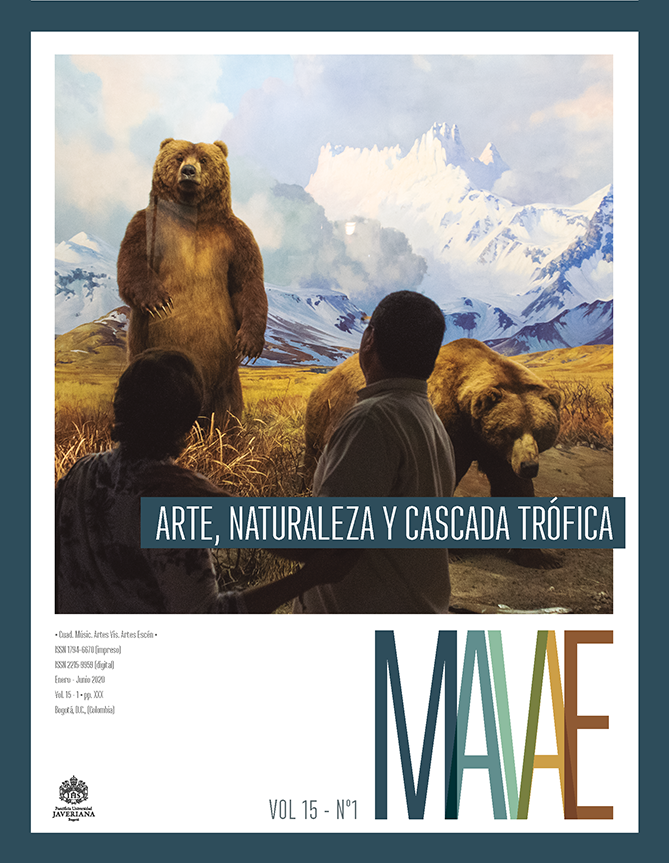Abstract
This article proposes to unveil the anthropic axis of the western hegemonic gaze to understand how it operates and how it generates such a point of view. The objectives of such deconstruction have to do with analyzing what this anthropic axis shows and what it does not and, thus, learn more about the image, its creator, and its observer. It also aims to present the possibilities of establishing another apparatus that allows you to see someone else, to remove the human from the middle of the perceptual coordinates and to understand the human as a living being among living beings, whose lives deserve to be lived. It is important to establish that one of the ways in which the discourse of human exceptionality was constructed underwent the construction of the perceptual cube, a viewing apparatus that structures the ways of understanding the world after that invention. This, like every other, is a social apparatus that produces its user and its body. With this, it generates perspective, ways of describing the world, forms of intellection of phenomena; in other words, it builds an episteme or what we call a “gaze”. This article combines epistemological tools from the theory of image, philosophy, art history and visual studies to carry out the understanding of the viewing machine produced by the Renaissance and its manifestations of survival in today’s world.
Alpers, Svetlana. 1987. El arte de describir. El arte holandés en el siglo XVII. Madrid: Blume.
Bataille, Georges. (2003). La conjuración sagrada. Ensayos 1929-1939. Buenos Aires: Adriana Hidalgo.
Benjamin, Walter. 1990. “Yve-Alain Bois: Présentation. Peinture et graphisme. De la peinture ou le signe et la marque”. La Part de l’Oeil 6: 98.
— 2009. Obra completa. Madrid: Abada.
Bois, Yves-Alain y Rosalind Krauss. 1997. Formless: A User’s Guide. Nueva York: Zone Books.
Caillois, Roger. 1998. “Mimesis y psicastenia legendaria”. En El mito y el hombre. Traducido por Jorge Ferreiro. México: Fondo de Cultura Económica.
Caillois, Roger. 1984. “Mimicry and Legendary Psychasthenia”. October 31: 17-32. Della Mirandola, Pico. 2016. Discurso sobre la dignidad del hombre. México: Universidad Nacional Autónoma de México.
Durero, Alberto. 1525. Underweysung der Messung. Nuremberg: Publicado por Hieronymus Andreae, llamado Formschneyder
Foucault, Michel. 1993. Las palabras y las cosas. México: Siglo XXI.
Freedman, Barbara. 1991. Staging the Gaze: Postmodernism, Psychoanalysis, and Shakespearean Comedy. Nueva York: Cornell University Press.
Gould, Stephen Jay. 1997. La falsa medida del hombre. Barcelona: Crítica.
Haraway, Donna. 2016. Stayng with the Trouble. Making Kin in the Chthulucene. Durham, Duke University Press
Krauss, Rosalind. 1997. El inconsciente óptico. Madrid: Tecnos.
Leslie, Esther. 1997. Walter Benjamin. Londres: Reaktion Books.
Mauriceau, François. 1668. Traite des maladies des femmes grosses et de celles qui sont accouchées. París: Par la Compagnie des libraires.
Mitchell, W. J. Thomas. 1994. Teoría de la imagen. Madrid: Akal.
Management Sciences for Health. 2017. “Partería en México”.
Consultado el 20 de septiembre de 2019. https://mexico.unfpa.org/sites/default/files/pub-pdf/Parteria_en_Mexico.pdf
Nieto Olarte, Mauricio. 2019. Una historia de la verdad en Occidente. Ciencia, arte, religión y política en la conformación de la cosmogonía moderna. Bogotá: Fondo de Cultura Económica-Universidad de los Andes.
Rorty, Richard. 1996. Contingencia, ironía y solidaridad. Barcelona: Paidós.
--2002. “El ser al que puede entenderse, es leguaje” en Filosofía y futuro. Barcelona: Gedisa.
Schaeffer, Jean-Marie. 2009. El fin de la excepción humana. Buenos Aires: Fondo de Cultura Económica.
Welsch, Wolfgang. 2014. Hombre y mundo: filosofía en perspectiva evolucionista. Valencia: Pre-Textos.
This journal is registered under a Creative Commons Attribution 4.0 International Public License. Thus, this work may be reproduced, distributed, and publicly shared in digital format, as long as the names of the authors and Pontificia Universidad Javeriana are acknowledged. Others are allowed to quote, adapt, transform, auto-archive, republish, and create based on this material, for any purpose, provided the authorship is duly acknowledged, a link to the original work is provided, and it is specified if changes have been made. Pontificia Universidad Javeriana does not hold the rights of published works and the authors are solely responsible for the contents of their works; they keep the moral, intellectual, privacy, and publicity rights.
Approving the intervention of the work (review, copy-editing, translation, layout) and the following outreach, are granted through an use license and not through an assignment of rights. This means the journal and Pontificia Universidad Javeriana cannot be held responsible for any ethical malpractice by the authors. As a consequence of the protection granted by the use license, the journal is able to publish retractions or to correct information already published. Publishing contents in this journal does not generate royalties for contributors.


